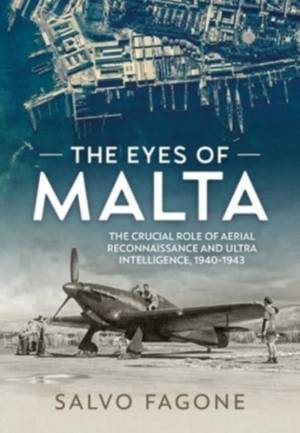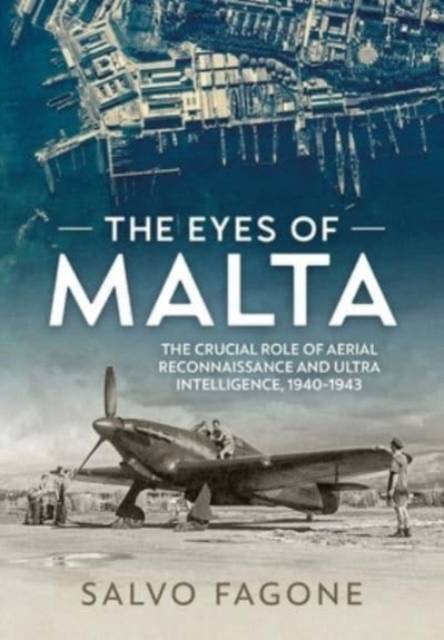
En raison d'une grêve chez bpost, votre commande pourrait être retardée. Vous avez besoin d’un livre rapidement ? Nos magasins vous accueillent à bras ouverts !
- Retrait gratuit dans votre magasin Club
- 7.000.000 titres dans notre catalogue
- Payer en toute sécurité
- Toujours un magasin près de chez vous
En raison de la grêve chez bpost, votre commande pourrait être retardée. Vous avez besoin d’un livre rapidement ? Nos magasins vous accueillent à bras ouverts !
- Retrait gratuit dans votre magasin Club
- 7.000.0000 titres dans notre catalogue
- Payer en toute sécurité
- Toujours un magasin près de chez vous
The Eyes of Malta
The Crucial Role of Aerial Reconnaissance and Ultra Intelligence, 1940-1943
Salvo Fagone
Livre broché | Anglais
48,95 €
+ 97 points
Description
"This book is highly recommended for students of the Mediterranean Theater. Besides accessing secondary sources, Falcone utilized Sicilian newspaper accounts as well as culling material from the national archives of several nations." -- The Journal of the Air Force Historical Foundation
During the Second World War, aerial reconnaissance in all its aspects - photographic, strategic, tactical and armed - played a leading role. The British, French, Americans, Germans and Italians all used this exceptional means of observation to try to understand the enemy's strategies in advance. This volume describes how things really went; it brings to light new details, revealing the way the war in Sicily, and in the Mediterranean in general, was influenced by aerial reconnaissance. Sicily was a proving ground for many reconnaissance techniques before, during and after its eventual invasion. The highly secret Ultra intelligence service also played a decisive role, anticipating the enemy's aerial and nautical activities. Finally, the strategic position of the island of Malta supported and facilitated the Allies. Heavily bombed throughout the first few years of the war, this tenacious island resisted admirably and became a thorn in the enemy's side as its reconnaissance aircraft repeatedly revealed Italian and German activities in North Africa, the Mediterranean, Sicily and greater Italy.
The war in the Mediterranean was a key to the entire global conflict. Stopping the Germans and Italians in North Africa meant the Suez Canal was safe, the rest of Africa was safe and the vital oilfields in the Middle East remained in the Allies' hands. Also, the war could only reach its end if the Germans were pushed out of Italy. Malta's strategic location meant it was crucial, as it has been for centuries, to controlling the 'middle sea'. Its role during the 1939-45 war is well known and has been told many times before. However, the focus has usually been on the defending fighters or the convoys fighting to get through. If aerial reconnaissance efforts are featured, only a very few key people have been mentioned. The same stories are often repeated. Here, though, for the first time, is the complete picture of Malta's role in wartime aerial reconnaissance.
Aerial reconnaissance during the Second World War in the Mediterranean has never been covered in this detail. The reconnaissance aircraft used throughout the Mediterranean during the war were, early on, a mixed bunch of odd types often doing a job they weren't designed for. As the war progressed, the aircraft became more specialized. The same can be said for the men who flew them, many of whom are quoted at length.
The many photographs, maps, diagrams and tables will appeal to all readers as they put faces to names while also keeping abreast of the bigger picture at the campaign level (and aerial reconnaissance's part in it).
Perhaps most importantly, the extensive personal recollections will help the reader looking to experience life and wartime flying in, often, unarmed aircraft. It is a window to a time and parts of the war few have studied.
During the Second World War, aerial reconnaissance in all its aspects - photographic, strategic, tactical and armed - played a leading role. The British, French, Americans, Germans and Italians all used this exceptional means of observation to try to understand the enemy's strategies in advance. This volume describes how things really went; it brings to light new details, revealing the way the war in Sicily, and in the Mediterranean in general, was influenced by aerial reconnaissance. Sicily was a proving ground for many reconnaissance techniques before, during and after its eventual invasion. The highly secret Ultra intelligence service also played a decisive role, anticipating the enemy's aerial and nautical activities. Finally, the strategic position of the island of Malta supported and facilitated the Allies. Heavily bombed throughout the first few years of the war, this tenacious island resisted admirably and became a thorn in the enemy's side as its reconnaissance aircraft repeatedly revealed Italian and German activities in North Africa, the Mediterranean, Sicily and greater Italy.
The war in the Mediterranean was a key to the entire global conflict. Stopping the Germans and Italians in North Africa meant the Suez Canal was safe, the rest of Africa was safe and the vital oilfields in the Middle East remained in the Allies' hands. Also, the war could only reach its end if the Germans were pushed out of Italy. Malta's strategic location meant it was crucial, as it has been for centuries, to controlling the 'middle sea'. Its role during the 1939-45 war is well known and has been told many times before. However, the focus has usually been on the defending fighters or the convoys fighting to get through. If aerial reconnaissance efforts are featured, only a very few key people have been mentioned. The same stories are often repeated. Here, though, for the first time, is the complete picture of Malta's role in wartime aerial reconnaissance.
Aerial reconnaissance during the Second World War in the Mediterranean has never been covered in this detail. The reconnaissance aircraft used throughout the Mediterranean during the war were, early on, a mixed bunch of odd types often doing a job they weren't designed for. As the war progressed, the aircraft became more specialized. The same can be said for the men who flew them, many of whom are quoted at length.
The many photographs, maps, diagrams and tables will appeal to all readers as they put faces to names while also keeping abreast of the bigger picture at the campaign level (and aerial reconnaissance's part in it).
Perhaps most importantly, the extensive personal recollections will help the reader looking to experience life and wartime flying in, often, unarmed aircraft. It is a window to a time and parts of the war few have studied.
Spécifications
Parties prenantes
- Auteur(s) :
- Editeur:
Contenu
- Nombre de pages :
- 396
- Langue:
- Anglais
Caractéristiques
- EAN:
- 9781804512418
- Date de parution :
- 21-08-23
- Format:
- Livre broché
- Format numérique:
- Trade paperback (VS)
- Dimensions :
- 183 mm x 254 mm
- Poids :
- 272 g

Les avis
Nous publions uniquement les avis qui respectent les conditions requises. Consultez nos conditions pour les avis.






